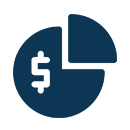Why Lease?
The Advantages Of Leasing Your Fleet,
The Alternate Financing Method.
Leasing is a very different and unique way of financing a vehicle compared to traditional loan options. Simply put: leasing allows for vehicle use over time at a lower monthly cost, freeing up cash for other purchases. When you lease, you get more from a vehicle for less money!
Advantages Of Leasing
Lower down payment
Affordable payments with shorter terms
Drive a newer, better vehicle for less money each month
Lower repair costs (with a three-year lease, the manufacturer warranty covers most repairs)
No trade-in hassles at the end of the lease
Only pay sales tax on the depreciated portion of the vehicle
Tax Savings With A Vehicles Lease Compared To A Loan
With leasing, taxes are collected on the monthly lease payment throughout the term of the lease. With a loan, all taxes on the vehicle price are paid upfront. As a result, you end up paying interest on this tax amount. If you choose to purchase the vehicle upon the expiry of the lease, you then pay the tax on the residual value.
For example: If an individual normally likes to drive a different vehicle every three years, a 36-month lease would allow them to pay only for the desired usage and then obtain a new vehicle. If the same individual financed a vehicle over a 72-month period on a loan, they would be left with the hassle of trying to sell the vehicle privately or potentially losing money by trading in the vehicle after 36 months.
Only Pay For What Your Use
With a traditional loan, the vehicle is written down to a zero balance, typically over a 60 or 72-month term. In contrast, a lease is based on the anticipated use of a vehicle over a specific period and places a value reflecting that expected usage. This period is measured in months and can range from 6 to 60.
Because you only pay for the portion of depreciation used when leasing, lease payments can be much lower per month compared to loan payments. This allows you to drive a more expensive, better-equipped car for the same payment as a traditional loan.
Examining The Two Basic Types Of Leases

Open-End Leases
Open-End Leases, or “'no kilometre restriction leases,” allow you to lease a vehicle without any kilometre restriction because you guarantee the residual or end value of the vehicle. If you are a high mileage driver, your TransCan Leasing Representative can work with you to determine a reasonable end-value based on your expected usage.

Closed-End Leases
Closed-end leases, or “walk away” leases, enable you to walk away at the end of a lease with no further obligation (provided the car is not damaged, has not been subjected to excessive wear and tear, and kilometre restrictions have not been exceeded). With a closed-end lease, the leasing company guarantees the residual or end value of the vehicle.
Leasing Vs. Financing Frequently Asked Questions
1. How does a lease work?
With a lease, you are only paying for the use of the vehicle, which means you only pay for the amount of depreciation used. This is the difference between what the car is worth now and the projected value at the end of the lease term (plus interest and taxes).
For example: If a vehicle is worth $20,000 new and its projected value at the end of the lease is $15,000, then the amount of depreciation, and what you would pay, is $5,000 (plus interest and taxes). Lease payments are almost always between 30-40% lower than conventional financing. Leasing is a greater way to not only defer taxes and spread out depreciation but also to afford and drive a more expensive or newer vehicle with the factory warranty still intact.
2. Is it more expensive to lease than finance?
While the total cost of leasing and financing can be similar, leasing has the benefit of protecting you from future risks, such as costly repairs. By leasing, you can always drive a vehicle with the full factory warranty intact. Further, leasing typically carries a lower monthly payment (see FAQ #1).
3. Am I able to apply a downpayment or trade in my current vehicle?
Yes. A down payment is essentially one large lease payment, which reduces the monthly purchase price of your leased vehicle. As a result, the balance of depreciation over the term is lower, meaning your payments will be lower. However, any down payment or capital cost reduction is taxable and will minimize the tax deferral benefit of leasing. A trade-in is different because there are tax credits available. This means you will benefit from lower payments as well as minimizing the tax payable. Alternatively, the trade-in equity could be paid back directly to be utilized as you wish.
4. Am I able to lease any vehicle?
Yes, TransCan Leasing will lease any make and model of new and nearly new vehicles. Our expert Lease Representatives have connections to a vast network of dealerships and the experience and resources to find the vehicle that's right for you and your budget.
*It is important to note: At a certain point, older vehicles will lose the benefits of leasing due to the calculated depreciation and minimal warranty coverage.
5. Am I responsible for repairs and maintenance of my leased vehicle?
Yes, you will be responsible for following the manufacturer's maintenance requirements. At the end of the lease, you must provide up-to-date service records per the manufacturer's specifications. This question raises one of the main advantages of leasing: With a lease on a new vehicle, the manufacturer's warranty is typically still intact. This means you have the potential to be protected from any unexpected repair bills.
You will also be responsible for excess wear and tear should you return the leased vehicle to TransCan Leasing at the end of your lease term.
Excess Wear and Tear Includes
• Glass which has been damaged, chipped, cracked, scratched or tinted
• Damaged body, fenders, metal work, lights, trim or paint; any scratch through the paint in excess of 3/4 of an inch, and body dents in excess of 1/2 inch wide
• Missing equipment which was in or on the vehicle when delivered and has not been replaced with equipment of equal quality and design
• Missing or unsafe wheels or tires (including the spare; snow tires are not acceptable)
• Any tire (including the spare) with less than 1/4 inch of tread remaining at the shallowest point
• Damage or stained dash, floor covers, seats, headliner, upholstery, interior work, or truck liners
• Any mechanical damage or other condition that causes the vehicle to operate in a noisy, rough, improper, unsafe, or unlawful manner
• Any other damage, whether or not it is covered by insurance
• Missing wheel covers, jack or wheel wrench





